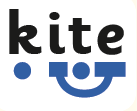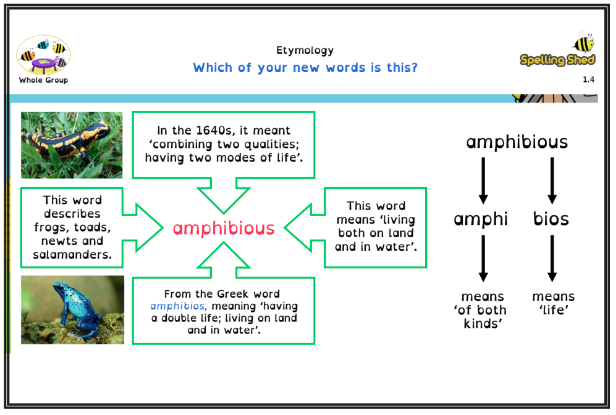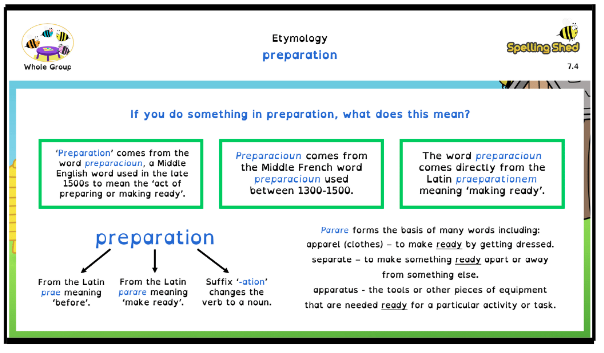Spelling Shed Guidance
In 2017, Spelling Shed was launched as a standalone app available for Apple and Android devices by founders Rob Smith and Martin Saunders. Soon afterwards, it became the #1 spelling app in the UK and across a range of other territories. In 2019, we added the first version of our spelling scheme which included a weekly spelling lesson and teaching resources. This proved popular and now well over 20 million children around the world have had access to Spelling Shed resources. Over the past half a decade, we have continued to research the best spelling principles and pedagogical practices which has led us to develop a new Spelling Scheme for 2022. This guidance should explain what is new and why we have included specific learning outcomes and activities.

What is included in a Spelling Shed lesson?
Each lesson has a main objective from the National Curriculum appendix for spelling. This may be split across multiple bullet points.
We know that many schools’ timetables are bursting at the seams and, with this in mind, we have designed each lesson as a number of modular components which can be taught as a single lesson per week or split into a number of sessions to be delivered over the course of a week.
For example, you may decide to have three sessions per week as below.
- Session 1: 20 mins, Revise and Introduction
- Session 2: 20 mins, Main Teaching Input
- Session 3: 20 mins, Independent and Consolidation
Objectives
Each week a set of words is provided, these words are examples of the spelling pattern. In the example (right) the words contain the letter string ‘ch’ which is pronounced /sh/ in this context.
Revise
Each lesson contains a revision section which should last approximately 5 minutes. Children will revisit sounds and spelling patterns from earlier weeks in the scheme.
Introduction
In the introduction, children will be acquainted with the words of the week. There will be an explanation of how the words are linked. The lists are organised by spelling patterns, sounds or affixes. This section is designed to take approximately 10 minutes.
Examples of list titles:
- Words with the prefix inter-
- The /r/ sound spelled wr
- Words ending in -ible or -able
- The /j/ sound spelled as a g
There are a number of different activities that may be included in the introduction that also feature in the Main Teaching Input. See the Activities section for details.
Main Teaching Input
The Main Teaching Input section is designed to take approximately 20 minutes to complete. Here teachers and students will explore the words of the week. They will examine aspects such as the number of syllables, tricky sounds and the morphology of the words. There are a range of activities that appear in the Introduction and Main Teaching Input section of the lesson. See the Activities section for details.

Independent
The Independent section is designed to be carried out by students with minimal instruction. They can be carried out immediately after the teaching input in class during an extended spelling session or can be carried out later in an additional session or for home study. Each activity should take approximately 10-20 minutes to complete.
Consolidation
In the Consolidation section, a recap of the objectives will be carried out.
Lesson Sequence
The lesson sequence is planned to systematically build upon acquired knowledge, so we recommend that teachers start with Lesson 1 in their stage and move through the lessons in the order that they are presented. The only exception to this is Stage 6 where the first 10 lessons are based on challenge words so that statutory words can be learned prior to any statutory assessments. Teachers can choose to focus on these or start their sequence of learning at Lesson 11 and revisit the challenge weeks as and when appropriate to their cohort.
Challenge Weeks
Challenge weeks are lists of words made up from the statutory word lists found in the National Curriculum English Programme of Study Spelling Appendix 2. Stage 2’s Challenge Words are the CEW words found on page 10 of the appendix document. Stages 3 and 4’s Challenge Words can be found on page 23 and for Stages 5 and 6 they can be found on page 23 of the National Curriculum’s spelling appendix document. These lists appear throughout the scheme every 6 weeks. (Except in Stage 6 as per the note above.) Challenge Weeks offer an opportunity for children to put their learning into practise on words which may have unfamiliar or unusual spelling patterns. In the 2017 scheme, these lessons were made up by the teacher choosing a range of activities to use with the words; however, in the 2022 scheme, each of these lessons is fully planned and resourced.
The Programme of Study spelling appendix can be found here
Activities
Sorting Words
Sorting words according to sounds, e.g., sorting words containing ‘ou’ according to how it is pronounced /ow/, /or/, /oo/ or /u/.
Sorting words based on the number of sounds, e.g., found has four sounds f-ou-n-d and around has five sounds a-r-ou-n-d.
Syllable Maps (also known as orthographic mapping)
Students will break words down into syllables. They will be supported in this process before becoming more independent as they move through the programme.
Once a word has been broken down into syllables, then students will be encouraged to look for ‘tricky’ spellings within these parts. For example, in the word advancement there are three syllables: ad-vance-ment. Ad- and -ment are both simple spellings but there is a teaching point around the middle syllable -vance- where the ‘ce’ is pronounced /s/.
Similarly, in the word again there are two syllables. The ‘a’ is straightforward; however, in the word ‘gain’, the ‘ai’ digraph is a short /e/ and not the longer /a/ vowel sound as in the word ‘train’.
In some lessons, students will sort words according to the number of syllables.
Segmenting Words
In Spelling Shed lessons, students will continue to segment words. They will separate sounds or demarcate words to show individual sounds.
Students will be asked to identify sounds in order to aid their spelling and reading of words. For example, in the word sprout there are five sounds /s/ /p/ /r/ /ou/ /t/.
Students will be familiar with the different spellings of the graphemes from their experience of systematic synthetic phonics. Students will need to demonstrate this knowledge throughout their spelling lessons. For example, students will need to know that in sprout the digraph ‘ou’ represents the sound /ow/.
Note: If children are not secure in their grapheme/phoneme correspondence then further practice will be required.
There are two main ways of segmenting across the Spelling Shed scheme: ‘Sound Buttons’ and ‘Elkonin Boxes’.
Sound Buttons
When using sound buttons, students will use dots, dashes and arcs below words to indicate individual sounds.

For example, ‘jet’ is made up of three sounds. Phonemes which are all single letter graphemes represented by a dot below each of them.
‘Rocket’ is made up of five phonemes. There are four single-letter graphemes and one two-letter grapheme (digraph) which is identified by a dash. There are also trigraphs and quadgraphs in some words which can also be identified with a longer dash, for example, in the world ‘eight’.


‘Kite’ is made up of three graphemes, two of which are single letter graphemes; these are the /k/ and /t/ sounds. The long /i/ sound is made by the addition of the ‘e’. This is identified by linking the ‘i’ and the ‘e’ together with an arc.
In some instances, students may be asked to match the word with the correct pattern of sound buttons, for example, matching the word ‘naughty’ with 
Elkonin Boxes
Elkonin Boxes can be used to segment words into their component sounds.
Brochure becomes  with each box containing a single grapheme.
with each box containing a single grapheme.
- Note: The alphabetic code is not an exact science, whilst grapheme/phoneme correspondence is vital for early and emergent readers, by the time students are reading more complex vocabulary they may not need to rely on the sound buttons. There are also times when some rules have exceptions. For example, the ‘oe’ digraph in tomatoes becomes ‘-es’.
Alphabetise
The National Curriculum English Programme of Study has statutory elements which state that students should be taught to name the letters of the alphabet in order using letter names. There are a number of activities in Spelling Shed where students are asked to place words in alphabetical order. This will aid with using a dictionary/thesaurus and searching for content in an index or glossary which is a statutory requirement for children in KS2.
Cloze Sentences
Students will be asked to read sentences with their spelling words missing. They should insert each word word into the space in the sentence. In this activity, students will need to read, understand and write their spelling words correctly in context. We do feel there is little benefit in copying these sentences out in full and it is more effective to focus on the key spelling words.
Choose the Correct Spelling
Students will be presented with alternative close spellings of words such as ‘intrest’, ‘interest’ and ‘interrest’. Students need to identify the correct version. In this example, students will need to identify that in the first iteration, ‘intrest’ has been spelled as many people say the word with an elided ‘e’, and that ‘interrest’ has an extra ‘r’. Students’ knowledge of GPCs and morphology is utilised and therefore embedded further during this activity.
Morphology
Morphology is the study of words and their parts. In terms of their architecture, words can be placed into two distinct categories. Words such as ‘car’, ‘skill’ and ‘pen’ seem to exist in whole forms. The word as a whole holds the full meaning. The second category of words, such as ‘walking’, ‘inconceivable’ and ‘disagreement’, can be split into a number of sections with each section holding a portion of the whole meaning.
A morpheme is the smallest unit of meaning in a word. For example, the word ‘dogs’ is made up of two morphemes. These are ‘dog’ meaning a canine animal and ‘-s’ which pluralises the noun to show that there is more than one.
The word ‘disagreement’ can be split into three sections. The base word ‘agree’ and two affixes ‘dis-’ and ‘-ment’. ‘Dis-’ is a prefix added before the base word and ‘-ment’ is a suffix added after the base word. These morphemes can aid understanding of the word that is being read. Adding the suffix ‘-ing’ indicates an action. Adding ‘dis-’ as a prefix shows us that the word means ‘opposite of’, ‘not’, or ‘reverse’ of the base word meaning. For example, adding ‘dis-’ to ‘agree’ reverses its meaning.
Morphology Matrix
In many lessons, we use a Morphology Matrix to demonstrate how morphemes fit together.
In this example, students can create new words by adding affixes to the base word ‘round’.
The prefix ‘sur’ can be added to ‘round’ to create ‘surround’. The suffix ‘-ed’ can be added to the base word to make ‘rounded’. Both prefixes and suffixes can be added to the base to further change the meaning, e.g., ‘surrounded’.
Note: In some examples, the section title ‘Base Word’ is changed to ‘Root Word’. Base and root words are similar, they are both root words but a base word can stand alone and have meaning as in ‘round’ above. Whereas, root words do not always have a meaning of its own in English, these are often of Greek or Latin origins, for example:
- jur - meaning law or justice as in jury and jurisdiction,
- magn - meaning large or great as in magnificent,
- terr - meaning earth as in territory.
Etymology
In our revised scheme, we have included etymology activities in order to further study words. Looking at the etymology of words and word parts can help children to spot patterns which are helpful when spelling. For example the word giant comes, through French, from the Latin gigas (a giant) and Greek Gigas (race of monsters) which helps explain why the word begins with a ‘g’ rather than a ‘j’ and also shows where the word ‘gigantic’ comes from. It is interesting to note that ‘giant’ came through Old French and the middle ‘g’ was elided, whereas ‘gigantic’ came to English straight from Latin which is why it kept its middle ‘g’.
When looking at morphology it is worth noting that we can explore the word origins of both roots and affixes. To know that the root ‘sect’ means ‘to cut’ helps when looking at words ‘bisect’, ‘dissect’ and ‘intersection’. All three involve some cutting or splitting.
- Bisect means to cut in two.
- Dissect means to methodically cut up a living thing.
- Intersection means a place where one road cuts across another.
Having this knowledge can help with spelling because if students know that ‘sect’ to cut is spelt with ‘-ct’ at the end and not ‘-cked’ then whenever they come across this root in a word, then they know it is spelled ‘sect’.
Examples
In the example below students are presented with clues and asked to guess their new spelling word (in red) then a discussion takes place about the meaning of the parts of the word.

In this example, it is explained how the word preparation is constructed from a root and two affixes with distinct meanings.

Homework
Our online games are designed to be used in school or at home. Teachers can assign word lists to each student so that they can practise them at home via our online games. If children have limited access to a device at home, then we recommend that some time is given to these children to practise at school. This may be in the form of a lunchtime club or on a rotation basis using a class laptop/ipad.
The games can be accessed here: play.edshed.com
The modularised lesson plans allow for the independent activities to be carried out at home if required. If needed, children can take home one of these activities for additional practice.
One of the changes from the 2017 scheme is the removal of the Look - Say - Cover - Write - Check sheets. Our research has led us to remove them as they are often used as a time filler or for handwriting practice but have little impact on spelling. Research has shown that as little as 20 minutes per week of word study including discussing spelling patterns, morphological exploration and orthographic mapping can have a bigger impact on spelling than the repetitive daily copying of wordlists.






